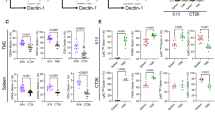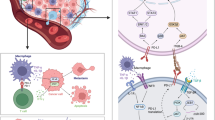Abstract
Background
Osteosarcoma (OS) is the most common malignant bone tumor and the prognosis of advanced cases is still poor. Recently, there have been several reports suggesting the relationship between innate immunity and OS, but the detailed mechanism is unknown. We demonstrate the relationship between OS and Toll-like receptor 4 (TLR4) which is one of the most important factors in innate immunity.
Methods
We established a syngenic mouse tumor model using C3H/HeN, C3H/HeJ mouse and a highly metastatic OS cell line, LM8. TLR4 activation with lipopolysaccharide (LPS) was performed on both mice and its influence on the progression of OS was evaluated. We also performed CD8 + cells depletion to examine the influence on TLR4 activation effects.
Results
Tumor volume of C3H/HeN mice was significantly smaller and overall survival of C3H/HeN mice was significantly longer than C3H/HeJ mice. We found more CD8+ cells infiltrating in lung metastases of C3H/HeN mice and depletion of CD8+ cells canceled the antitumor effects of LPS.
Conclusion
TLR4 activation by LPS increased CD8+ cells infiltrating into lung metastases and suppressed OS progression in the mouse model. TLR4 activation may suppress the progression of OS via stimulating CD8+ cells and can be expected as a novel treatment for OS.





Similar content being viewed by others
Abbreviations
- CLP:
-
Liposomal clodronate
- LPS:
-
Lipopolysaccharide
- OAS:
-
Overall survival
- OS:
-
Osteosarcoma
- PFS:
-
Progression-free survival
- S.D:
-
Standard deviation
- TAM:
-
Tumor-associated macrophage
- TLR:
-
Toll-like receptor
References
Iwamoto Y et al (2009) Multiinstitutional phase II study of neoadjuvant chemotherapy for osteosarcoma (NECO study) in Japan: NECO-93J and NECO-95J. J Orthop Sci 14(4):397–404
Teng MW et al (2015) From mice to humans: developments in cancer immunoediting. J Clin Invest 125(9):3338–3346
Wolchok JD et al (2017) Overall survival with combined nivolumab and ipilimumab in advanced melanoma. N Engl J Med 377(14):1345–1356
Byrd TT et al (2018) TEM8/ANTXR1-specific CAR T cells as a targeted therapy for triple-negative breast cancer. Cancer Res 78(2):489–500
Heumann D, Roger T (2002) Initial responses to endotoxins and Gram-negative bacteria. Clin Chim Acta 323(1–2):59–72
Hagerling C, Casbon AJ, Werb Z (2015) Balancing the innate immune system in tumor development. Trends Cell Biol 25(4):214–220
Wycislo KL, Fan TM (2015) The immunotherapy of canine osteosarcoma: a historical and systematic review. J Vet Intern Med 29(3):759–769
Jimmy R et al (2017) Effectiveness of mifamurtide in addition to standard chemotherapy for high-grade osteosarcoma: a systematic review. JBI Database System Rev Implement Rep 15(8):2113–2152
Molteni M, Gemma S, Rossetti C (2016) The role of Toll-Like receptor 4 in infectious and noninfectious inflammation. Mediators Inflamm 2016:6978936
Lascelles BD et al (2005) Improved survival associated with postoperative wound infection in dogs treated with limb-salvage surgery for osteosarcoma. Ann Surg Oncol 12(12):1073–1083
Jeys LM et al (2007) Post operative infection and increased survival in osteosarcoma patients: are they associated? Ann Surg Oncol 14(10):2887–2895
Sottnik JL et al (2010) Chronic bacterial osteomyelitis suppression of tumor growth requires innate immune responses. Cancer Immunol Immunother 59(3):367–378
Han S et al (2017) LPS alters the immuno-phenotype of glioma and glioma stem-like cells and induces in vivo antitumor immunity via TLR4. J Exp Clin Cancer Res 36(1):83
Yao RR et al (2018) M2-polarized tumor-associated macrophages facilitated migration and epithelial-mesenchymal transition of HCC cells via the TLR4/STAT3 signaling pathway. World J Surg Oncol 16(1):9
Fujiwara T et al (2011) Macrophage infiltration predicts a poor prognosis for human ewing sarcoma. Am J Pathol 179(3):1157–1170
Asai T et al (1998) Establishment and characterization of a murine osteosarcoma cell line (LM8) with high metastatic potential to the lung. Int J Cancer 76(3):418–422
Poltorak A et al (1998) Defective LPS signaling in C3H/HeJ and C57BL/10ScCr mice: mutations in Tlr4 gene. Science 282(5396):2085–2088
Buddingh EP et al (2011) Tumor-infiltrating macrophages are associated with metastasis suppression in high-grade osteosarcoma: a rationale for treatment with macrophage activating agents. Clin Cancer Res 17(8):2110–2119
Gomez-Brouchet A et al (2017) CD163-positive tumor-associated macrophages and CD8-positive cytotoxic lymphocytes are powerful diagnostic markers for the therapeutic stratification of osteosarcoma patients: an immunohistochemical analysis of the biopsies fromthe French OS2006 phase 3 trial. Oncoimmunology 6(9):e1331193
Baldridge JR et al (2004) Taking a Toll on human disease: Toll-like receptor 4 agonists as vaccine adjuvants and monotherapeutic agents. Expert Opin Biol Ther 4(7):1129–1138
Vacchelli E et al (2012) Trial watch: FDA-approved Toll-like receptor agonists for cancer therapy. Oncoimmunology 1(6):894–907
Coley WB (1893) A preliminary note on the treatment of inoperable sarcoma by the toxic product of erysipelas. Post-Graduate 8:278–286
Shetab Boushehri MA, Lamprecht A (2018) TLR4-based immunotherapeutics in cancer: a review of the achievements and shortcomings. Mol Pharm 15(11):4777–4800
Matsuo T et al (2009) Extraskeletal osteosarcoma with partial spontaneous regression. Anticancer Res 29(12):5197–5201
Haratani K et al (2017) Tumor immune microenvironment and nivolumab efficacy in EGFR mutation-positive non-small-cell lung cancer based on T790M status after disease progression during EGFR-TKI treatment. Ann Oncol 28(7):1532–1539
Fritzsching B et al (2015) CD8(+)/FOXP3(+)-ratio in osteosarcoma microenvironment separates survivors from non-survivors: a multicenter validated retrospective study. Oncoimmunology 4(3):e990800
Park JY et al (2009) Doxorubicin enhances CD4(+) T-cell immune responses by inducing expression of CD40 ligand and 4–1BB. Int Immunopharmacol 9(13–14):1530–1539
Galluzzi L et al (2015) Immunological effects of conventional chemotherapy and targeted anticancer agents. Cancer Cell 28(6):690–714
Won EK et al (2003) Analysis of the antitumoral mechanisms of lipopolysaccharide against glioblastoma multiforme. Anticancer Drugs 14(6):457–466
Adams S (2009) Toll-like receptor agonists in cancer therapy. Immunotherapy 1(6):949–964
Ribi E et al (1984) Lipid A and immunotherapy. Rev Infect Dis 6(4):567–572
Inagaki Y et al (2016) Dendritic and mast cell involvement in the inflammatory response to primary malignant bone tumours. Clin Sarcoma Res 6:13
Dumars C et al (2016) Dysregulation of macrophage polarization is associated with the metastatic process in osteosarcoma. Oncotarget 7(48):78343–78354
Griesmann H et al (2017) Pharmacological macrophage inhibition decreases metastasis formation in a genetic model of pancreatic cancer. Gut 66(7):1278–1285
Rezvani K et al (2017) Engineering natural killer cells for cancer immunotherapy. Mol Ther 25(8):1769–1781
Acknowledgements
We thank Dr. Tetsuzo Tagawa from Department of Surgery and Science, Graduate School of Medical Sciences, Kyushu University for kindly providing clinical samples of the patients with OS.
Funding
This work was supported by Grants-in-Aid for Young Scientists (18K16627, 19K16802), Grant-in-Aid for Scientific Research (18K09067) from the Japan Society for the Promotion of Science, a Grant from Japan Orthopedics and Traumatology Research Foundation Inc. (No. 332). Toshifumi Fujiwara was also recipient of Fukuoka Foundation for Sound Health Cancer Research Fund.
Author information
Authors and Affiliations
Contributions
KY, YM, and HY designed research; KY, AK, and ES performed research; YM, HY, EM, NS, and TF analyzed data; MN, SO, YO, and YN supervised research; KY and YM drafted the manuscript.
Corresponding author
Ethics declarations
Conflict of interest
The authors declare no conflict of interest.
Ethics approval and ethical standards
The study was conducted in accordance with the Declaration of Helsinki and approved by the Institutional Ethical Review Board of the Kyushu University (#27–420, 2016/3/31). The animal study was approved by the Institutional Ethical Review Board of the Kyushu University (#A28-160–0, 2017–3-31). Experiments involving animals were performed in compliance with the guidelines established by the Animal Care and Use Committee and this study was approved by the Institutional Review Board at Kyushu University.
Informed consent
Prior to the use of patient data and specimens in the study, written informed consent was obtained from all patients. They all agreed to use their clinical data and bio materials for this research and publication. Written informed consent was obtained also from the parents when the patient was a minor.
Animal source
C3H/HeN and C3H/HeJ mice were purchased from Kyudo (Saga, Japan).
Cell line authentication
LM8 mouse osteosarcoma cells were purchased from RIKEN BioResource Research Center (Tsukuba, Japan). Cell line authentication of LM8 was performed by RIKEN.
Additional information
Publisher's Note
Springer Nature remains neutral with regard to jurisdictional claims in published maps and institutional affiliations.
Electronic supplementary material
Below is the link to the electronic supplementary material.
Rights and permissions
About this article
Cite this article
Yahiro, K., Matsumoto, Y., Yamada, H. et al. Activation of TLR4 signaling inhibits progression of osteosarcoma by stimulating CD8-positive cytotoxic lymphocytes. Cancer Immunol Immunother 69, 745–758 (2020). https://doi.org/10.1007/s00262-020-02508-9
Received:
Accepted:
Published:
Issue Date:
DOI: https://doi.org/10.1007/s00262-020-02508-9




